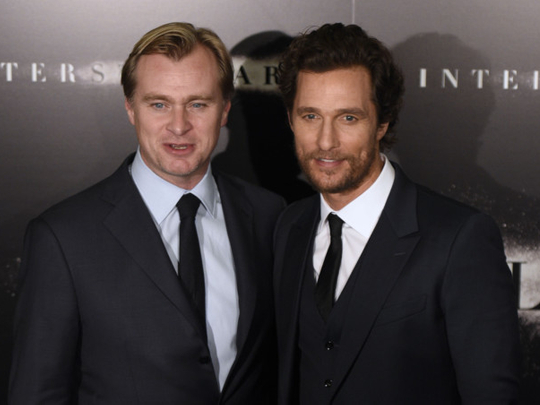
In his sci-fi extravaganza Interstellar, filmmaker Christopher Nolan isn’t just taking audiences to outer space. He’s also sending a couple of robots along for the ride — and they’re just not on board to sweep the floors.
“The idea was that they’d been designed to put humans at ease during extended periods of time,” said Interstellar screenwriter Jonathan Nolan. “They were originally conceived as Marines and programmed to engender the kind of comradery that a Marine would, so they’ve been programmed with a sense of humour and variable levels of honesty.”
The sleek grey ‘bots, which can be briefly glimpsed in the movie’s trailers, are walking-and-talking rectangular slabs of shiny metal that operate like a cross between a Swiss army knife and an iPhone. Their blocky fragments can disconnect and rotate to perform a variety of actions, from pushing buttons to cartwheeling across alien planets.
A particularly acerbic robot named TARS (portrayed by Bill Irwin) accompanies a team of astronauts led by Matthew McConaughey’s pilot Cooper to find humankind a new home after an ecological disaster wrecks Earth. “If anything, he’s the one Cooper gets along with the most out of anyone up there,” said McConaughey.
You have robots in this movie. What did you hope to achieve with those characters?
Nolan: I wanted a more realistic approach to what a robot would be. I didn’t even call them robots in the script. I referred to them as “articulated machines” because I wanted my crew and everybody to stop thinking of your standard idea of a robot. I wanted to have a machine in the film that was like a piece of gear — very tough, very resilient — that had been designed for whatever purpose best suited it.
How did you approach the design of TARS? He’s different from other robots we’ve seen in film.
As we pushed the concept further, it became a very minimalist appearance that disguises very complex functionality. My idea was to remove any trace of anthropomorphism, so it doesn’t have a face. It doesn’t have arms and legs. It does have a voice, and therefore a personality. The great Bill Irwin, who was puppeteering and voicing TARS, was able to give an inanimate, non-human object a personality.
For their shape, were you inspired by the monolith from ‘2001: A Space Odyssey’?
I think, in its science fiction context, inevitably your mind goes to that — and that’s fine by me. Definitely, the spirit of 2001 hangs over the film. It was one of our aspirations to pay homage to that film. It also relates strongly to the architecture of Mies van der Rohe. As we honed in on the idea, I asked my designer [Nathan Crowley], who’s a very big fan of modern architecture: What if we designed a robot as if Mie van der Rohe designed a robot? I think he really nailed it.
The robots actually help drive the story forward. How important was that to you?
In my brother’s draft, he was really into robots and artificial intelligence. What I wound up focusing on was the issue of why you need human beings on this mission. The robots are presented as being physically superior to humans and able to lift heavier things and follow orders perfectly. We kept coming back to the idea of intuition, human adaptability and innovation. That’s driven by a survival instinct, which a robot can’t have. That makes the robots very important in the story. They take on their own incredible personalities, but they’re not human. They keep you thinking about what it means to be human.
What was your biggest challenge in balancing an intimate family story with an intergalactic journey?
The biggest challenge in that respect is creating a reality on set so that the actors, who are very much the human element of that — they’re the intimate, emotional element of that — so that they can actually connect with the larger scale of the film, they can see it, touch it, taste it. So we tried to build our sets not so much like sets, more like simulators, so the actors could look out of the windows and see the real views of what would be going on there, they could experience the ship shaking and reacting as they flew it.
Why did you choose to set ‘Interstellar’ in a future that bears close resemblance to the present world?
I want to abandon the idea of futurism in design because ... it requires an enormous amount of energy and design that I felt could be better spent just achieving a recognisable sense of reality. So, we abandoned the idea of futurism in the design and we said ‘let’s make everything comprehensible and recognisable to today’s audience.’ There are a lot of leaps we’re asking the audience to make in terms of engaging with a story which takes them places they haven’t been before, so I think rooting the basic design of the film in the things that people know now is helpful.











